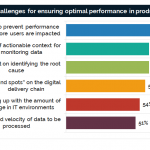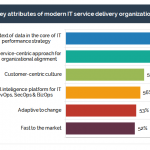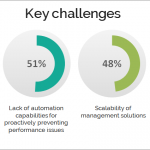Digital Enterprise Journal (DEJ)’s recent study revealed a 2.1 times increase in the number of organizations using technology to differentiate from competitors since 2017. Additionally, the research shows a 4.5x increase in the number of organizations making software a core part of their business strategy over the same period of time. As organizations are increasingly tasked with creating new customer experiences and using technology to create new revenue streams, the speed to the market is becoming more important. However, getting new applications and digital services to the market faster comes with a set of new management challenges.
Business context
DEJ’s 2019 study on managing IT operations revealed that organizations are losing, on average $126,000 per hour of unplanned down time. However, DEJ’s 2017 research shows that revenue losses due to service availability, as significant as they are, are just a smaller part of the picture. Even though the impact of performance slowdowns is lower per incident, as compared to issues with availability, these problems are occurring nearly 10 times more frequently. As a result, organizations are losing, in aggregate, nearly twice as much due to issues with speed of applications, as compared to service outages.
As heavy as the impact of issues with availability and performance on key business goals has been, new requirements of digital economy are creating a new dimension that is even more significant. Organizations in DEJ’s research are reporting a 3.1 times increase in missed revenue due to slow software delivery, since 2016. Additionally, organizations are reporting $2.219 million average estimated revenue loss, per month, due to performance related slowdowns in application release times.
It’s apparent that the inability to find the right balance between innovation, speed and reliability is causing a major business impact. However, market dynamics around increased customer expectations and new business requirements are being met with a lot of innovation in the technology vendor landscape and we are seeing a number of emerging trends that are well positioned to address key management challenges.
Key areas for enabling engineering teams
DEJ’s research identified 7 key areas that are making the strongest impact on the ability of engineering teams to create a business value.
Automation
DEJ’s new study “19 Key Areas Shaping IT Performance Markets in 2020” shows that automation capabilities are becoming increasingly important in each area of designing and delivering digital services. Eighty-one percent of organizations ranked importance of automation capabilities for their ‘Continuous Everything” initiatives (CI, CD and continuous reliability and resilience) as “high” or “very high”. Additionally, top performing organizations -TPOs (the class of organizations whose performance falls into the top 20% of research participants) has shown a strong understanding of the importance of automation capabilities, especially when it comes to managing dynamic environments (microservices, etc), runbook automation and proactively preventing performance issues. The research shows that TPOs are 2.1 times more likely to have capabilities for automated continuous discovery of changes in their environments and 77% more likely to have automated processes for preventing performance issues before they go to production.
Observability
As the complexity of managing dynamic environments is increasing, organizations are looking to gain more visibility into each component of their services. Twenty-seven percent of organizations in DEJ’s new study reported that they are looking to deploy machine learning powered solutions in 2020. However, DEJ’s 2019 study “The Roadmap to Becoming a Top Performing Organization in Managing IT Operations” revealed that inefficient processes for analyzing log data is a key challenge for 52% of organizations. Additionally, 59% reported that they are struggling with correlating IT data from different domains.
Figure 1
Figure 1 shows the key challenges for ensuring optimal performance in production and the concept of observability is designed to uniquely address each of them. Observability is especially important for engineering teams, as it allows them to gain visibility into performance areas that are especially important for their area of responsibility. Findings of DEJ’s upcoming study “Enabling Top Performing Engineering Teams” show that 65% of engineers (out of these that are familiar with this concept) see the value in implementing Observability in their organizations.
Continuous Everything
DEJ’s research shows an 8.6 times increase in software releases and upgrades since 2016 and a 2.7 times increase in new technology deployments over the same time period. The research also shows a 65% increase in the number of organizations that are deploying a CI/CD approach over the last 18 months, with 59% reporting that these practices are strategically important to their business. This approach translates into measurable benefits, as the research shows that organizations that are deploying automated CI/CD capabilities are reporting a 6.6x decreases in deployment times.
However, organizations are looking to apply the same approach when it comes to ensuring reliability in production. Forty-eight percent of organizations reported the need for ensuring reliability pass QA gates while 41% are looking to extend code feedback loops to include production.
This shows that organizations are increasingly understanding that as customer expectations and requirements to contribute to the business are continuously changing, they need to take the same approach and enable continuous integration, delivery and production performance assurance.
Data and knowledge management
Seventy-one percent of organizations in DEJ’s research reported that their IT data is not actionable. Additionally, DEJ’s new study shows that creating actionable insights is the name of the game for managing IT performance. Providing actionable and business-centric context around for monitoring data, while democratizing this data and enabling access to different job roles, is the key for enabling engineering teams to focus on creating a business value.
Fifty-three percent of TPOs reported that they have each of 1) customer-centric; 2) platform-based and 3) lifecycle approach as a part of their IT incident management strategies. Additionally, 68% of organizations described capabilities for postmortem analysis as “important” or “very important”.
Strong analytics, collaboration and knowledge management capabilities are playing a key role in enabling engineering teams, especially those that are distributed or working remotely. DEJ’s research shows that organizations that have these capabilities in place are reporting 51% fewer incidents escalated, as compared to all others.
Culture change
DEJ’s study shows a 2.2 times increase in the number of organizations in which DevOps plays a strategic role, since 2017. The research also shows that the adoption of DevOps culture is cutting across all the key areas of IT performance management. Thirty-six percent of organizations reported that they are looking to modernize IT Ops around DevOps principles (agility, automation, knowledge management, etc.) while 32% are looking to establish full service ownership – from development to production.
The attributes of DevOps culture are also impacting how organizations are aligning their processes and building a new type of IT service delivery organizations. Figure 2 shows that some of the core principles of DevOps culture, such as a customer-centric approach, speed to the market and constantly learning and being adaptive to change, have become organizational initiatives and are shaping how organizations are using technology to create a business value.
Figure 2
Enabling operational resilience
Top performing organizations (TPOs) in DEJ’s research reported a 79% success rate in preventing performance issues before users are impacted, as compared to 39% of problems proactively resolved for all others. The research also shows that TPOs are 3.4 times more likely to have strategies and processes in place to ensure resilience of their systems. Some of the key parts of these strategies are failover testing, chaos engineering and full visibility into their IT environments.
Operation resilience is an area where many of the strategies discussed above come together. To ensure that their systems are enabled to cope with any type of unplanned event that can impact user experience, organizations need to be taking a strategic approach that includes continuous testing, highly automated processes and strong capabilities for collaboration and knowledge management.
Strategic approach
DEJ’s research shows that TPOs are 81% more likely to have a strategy for enabling Dev and Engineering teams to focus on creating a business value. As a result, these organizations are experiencing, on average, 58% less trouble tickets issued, as compared to all others. Additionally, the chart below shows some of the key challenges that organizations are looking to address.
In order to address these challenges and enable engineering and DevOps teams to focus on creating a business value, organizations need to take a strategic approach built on the following principles:
- Customer-centric approach and innovation at the speed of customer
- Proactive mindset for dealing with performance issues
- Adopting SRE practices and focus on a new set of goals and metrics (SLO, SLI, etc.)
- Automation and context of data in the core of the strategy
- Continuous Everything
- Fully embracing the DevOps culture
- Processes for operational resilience
- Full real-time visibility into their environments
- Processes for cost and resource optimization
- Scalability and time to value as selection criteria
- Evaluate everything from the business perspective
TPOs in DEJ’s research are reporting 5.1 times faster delivery times while experiencing 20 points higher customer satisfaction scores (94 as compared to 74 points), as compared to all others. Implementing a strategy based on these 11 principles is a path for organizations to achieve that level of performance.















